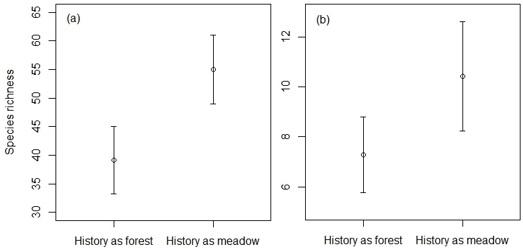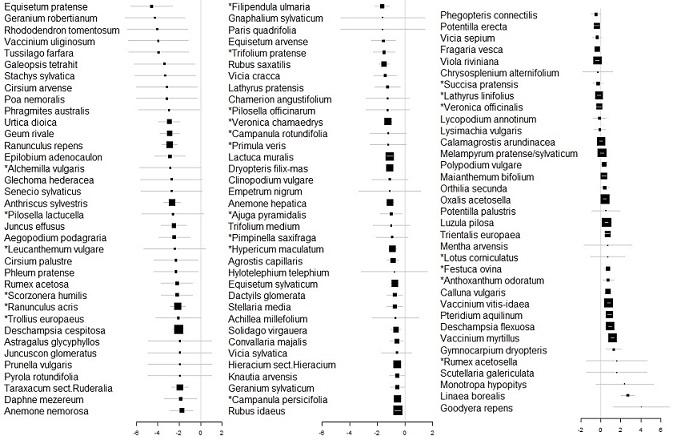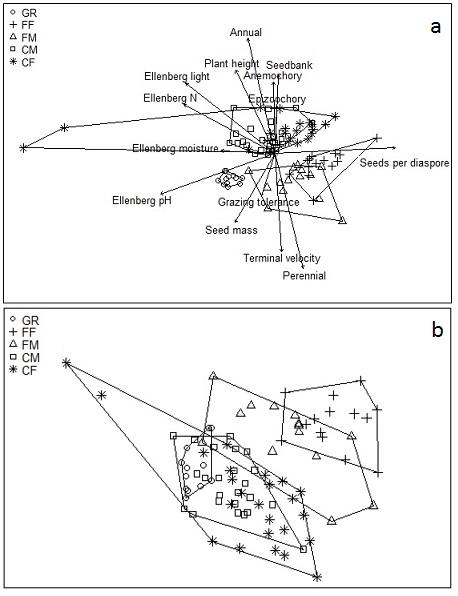Results
In total, 169 plant species were found during the survey in forests and grasslands (Grasslands = 133 species, forests with a history as forest = 90, forest with a history as meadow = 134). Out of these 48 species were classified as grassland indicator species (Grasslands = 46 species, forests with a history as forest = 19, forest with a history as meadow = 27). The average species richness were 29.6% higher in forests with a history as meadow compared to in forests with a history as forest (Figure 1). Also, the richness of grassland indicator species were 30.1% higher in forests with a history as meadow.

Figure 1: Average species richness and corresponding 95% Cl with 14 sites of forests with a history as forest and 14 sites as meadow for (a) all species and (b) species classified as grassland indicator species.
The majority of species prefers forests with a history as meadow compared to forests with a history as forest (Figure 2). A total of 107 species were included in the analysis and 53 of them showed distinct preference (95% Cl did not overlap zero) towards forests with a history as meadow, compared to 14 for forest with a history as forest. Out of 23 grassland indicator species included in the forest plot, 10 showed a distinct preference towards forest with a history as meadow and 2 showed preference for forests with a history as forest.

Figure 2: Odds ratio (natural logarithm) and corresponding 95% confidence interval for species in forests differing in land use history. Positive values of a species indicate preference towards forests with history as forest and negative values indicates a preference towards forest with history as meadow. Species labelled with a “*” are classified as grassland indicator species

Land use history affect both the species and trait composition in forests and clear-cuts (Figure 3). Forests and clear-cuts with a history as meadow tend to be more similar to grasslands regarding both species and trait composition compared to areas with a history as forest. Based on trait composition, clear-cuts tend to be more similar to grasslands compared to forests. Light and nitrogen demanding species were more represented in clear-cuts compared to forests or grasslands. Traits associated with clear-cuts were high anemochory and epizoochory. Tall species as well as species able to form persistent seed banks were more common in clear-cuts than in forests and grasslands. Annuals were more common in clear-cuts and perennials were more common in forests and tend to be more common in grasslands. Grazing tolerant species as well as species with high seed mass tend to be associated with grasslands and forests with a history as meadow.
Figure 3: Each symbol in the figures represent one of 88 site (GR = Grasslands, FF = forests with a history as forest, FM = Forest with a history as meadow, CM = clear-cuts with a history as meadow, CF = clear-cuts with a history as forest) and the 88 sites are divided in 12 GR, 14 FF, 14 FM, 24 CM and 24 CF. a: Non-metric multidimensional scaling (NMDS) based on the frequency of 212 plant species. Arrows illustrates plant traits and are based on community weighted means per site. b: Non-metric multidimensional scaling (NMDS) based on the community weighted mean values of 14 traits.
Responsible for this page:
Director of undergraduate studies Biology
Last updated:
05/18/15
